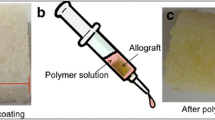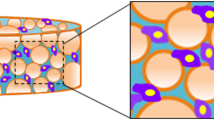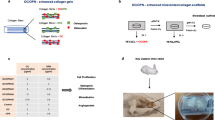Abstract
In this study, we used extracellular matrix (ECM) gels and human bone allograft as matrix vehicles to deliver the sphingolipid growth factor FTY720 to rodent models of tibial fracture and a critical-sized cranial defect. We show that FTY720 released from injectable ECM gels may accelerate callous formation and resolution and bone volume in a mouse tibial fracture model. We then show that FTY720 binds directly to human trabecular allograft bone and releases over 1 week in vitro. Rat critical-sized cranial defects treated with FTY720-coated grafts show increases in vascularization and bone deposition, with histological and micro-computed topography (microCT) evidence of enhanced bone formation within the graft and defect void. Immunohistochemical analysis suggests that osteogenesis within FTY720-coated grafts is associated with reduced CD68+ macrophage infiltration and recruitment of CD29+ bone progenitor cells. Matrix binding of FTY720 thus represents a promising and robust bone regeneration strategy with potential clinical translatability.






Similar content being viewed by others
References
Jacobs J, Andersson G, Bell J-E, Weinstein S, Dormans J, Gnatz S, Lane N, Puzas J, St. Clair EW, Yelin E. The burden of musculoskeletal diseases in the United States. Am Acad Orthop Surg. 2008.
Jahangir A, Nunley R, Mehta S, Sharan A. Bone-graft substitutes in orthopaedic surgery, in AAOS Now. Am Acad Orthop Surg. 2008.
Giannoudis PV, Dinopoulos H, Tsiridis E. Bone substitutes: an update. Injury. 2005;36 Suppl 3:S20–7.
Summers BN, Eisenstein SM. Donor site pain from the ilium. A complication of lumbar spine fusion. J Bone Joint Surg (Br). 1989;71(4):677–80.
Delloye C et al. Bone allografts: what they can offer and what they cannot. J Bone Joint Surg (Br). 2007;89(5):574–9.
Wheeler DL, Enneking WF. Allograft bone decreases in strength in vivo over time. Clin Orthop Relat Res. 2005;435:36–42.
Wu N et al. Health care utilization and costs in patients experiencing bone fracture nonunion. Value Health. 2012;15(4):A66.
Wieghaus KA et al. Small molecule inducers of angiogenesis for tissue engineering. Tissue Eng. 2006;12(7):1903–13.
Awojoodu AO et al. Sphingosine 1-phosphate receptor 3 regulates recruitment of anti-inflammatory monocytes to microvessels during implant arteriogenesis. Proc Natl Acad Sci U S A. 2013;110(34):13785–90.
Das A et al. The promotion of mandibular defect healing by the targeting of S1P receptors and the recruitment of alternatively activated macrophages. Biomaterials. 2013;34(38):9853–62.
Das A et al. Delivery of S1P receptor-targeted drugs via biodegradable polymer scaffolds enhances bone regeneration in a critical size cranial defect. J Biomed Mater Res A. 2014;102(4):1210–8.
Huang C et al. Local delivery of FTY720 accelerates cranial allograft incorporation and bone formation. Cell Tissue Res. 2012;347(3):553–66.
Sefcik LS et al. Sustained release of sphingosine 1-phosphate for therapeutic arteriogenesis and bone tissue engineering. Biomaterials. 2008;29(19):2869–77.
Sefcik LS et al. Selective activation of sphingosine 1-phosphate receptors 1 and 3 promotes local microvascular network growth. Tissue Eng A. 2011;17(5–6):617–29.
Brinkmann V et al. Fingolimod (FTY720): discovery and development of an oral drug to treat multiple sclerosis. Nat Rev Drug Discov. 2010;9(11):883–97.
Petrie Aronin CE et al. FTY720 promotes local microvascular network formation and regeneration of cranial bone defects. Tissue Eng A. 2010;16(6):1801–9.
Semete B et al. In vivo evaluation of the biodistribution and safety of PLGA nanoparticles as drug delivery systems. Nanomedicine. 2010;6(5):662–71.
Shive MS, Anderson JM. Biodegradation and biocompatibility of PLA and PLGA microspheres. Adv Drug Deliv Rev. 1997;28(1):5–24.
Ji W et al. Biocompatibility and degradation characteristics of PLGA-based electrospun nanofibrous scaffolds with nanoapatite incorporation. Biomaterials. 2012;33(28):6604–14.
Lu JM et al. Current advances in research and clinical applications of PLGA-based nanotechnology. Expert Rev Mol Diagn. 2009;9(4):325–41.
Makadia HK, Siegel SJ. Poly Lactic-co-Glycolic Acid (PLGA) as biodegradable controlled drug delivery carrier. Polymers (Basel). 2011;3(3):1377–97.
Dennis SC et al. Endochondral ossification for enhancing bone regeneration: converging native extracellular matrix biomaterials and developmental engineering in vivo. Tissue Eng B Rev. 2014;21(3):247–66.
Benders KEM et al. Extracellular matrix scaffolds for cartilage and bone regeneration. Trends Biotechnol. 2013;31(3):169–76.
Singelyn JM et al. Naturally derived myocardial matrix as an injectable scaffold for cardiac tissue engineering. Biomaterials. 2009;30(29):5409–16.
Sreejit P, Verma RS. Natural ECM as biomaterial for scaffold based cardiac regeneration using adult bone marrow derived stem cells. Stem Cell Rev Rep. 2013;9(2):158–71.
Neal RA et al. Alignment and composition of laminin-polycaprolactone nanofiber blends enhance peripheral nerve regeneration. J Biomed Mater Res A. 2012;100A(2):406–23.
Hastings CL et al. Drug and cell delivery for cardiac regeneration. Adv Drug Deliv Rev. 2014;84:85–106.
Tang PH et al. Effective and sustained delivery of hydrophobic retinoids to photoreceptors. Invest Ophthalmol Vis Sci. 2010;51(11):5958–64.
Wallace DG, Rosenblatt J. Collagen gel systems for sustained delivery and tissue engineering. Adv Drug Deliv Rev. 2003;55(12):1631–49.
Butcher JT et al. Quantitative volumetric analysis of cardiac morphogenesis assessed through micro-computed tomography. Dev Dyn. 2007;236(3):802–9.
Savai R et al. Evaluation of angiogenesis using micro-computed tomography in a xenograft mouse model of lung cancer. Neoplasia. 2009;11(1):48–56.
Das A, et al. Delivery of bioactive lipids from composite microgel-microsphere injectable scaffolds enhances stem cell recruitment and skeletal repair. PLos One. 2014;9(7).
Bax BE, Wozney JM, Ashhurst DE. Bone morphogenetic protein-2 increases the rate of callus formation after fracture of the rabbit tibia. Calcif Tissue Int. 1999;65(1):83–9.
McKibbin B. The biology of fracture healing in long bones. J Bone Joint Surg (Br). 1978;60-B(2):150–62.
Heilmann A et al. Systemic treatment with the sphingosine-1-phosphate analog FTY720 does not improve fracture healing in mice. J Orthop Res. 2013;31(11):1845–50.
Sato C et al. Sphingosine 1-phosphate receptor activation enhances BMP-2-induced osteoblast differentiation. Biochem Biophys Res Commun. 2012;423(1):200–5.
Bertran CA, Bertazzo S, Faria LP. Surface charge of hydroxyapatite and bone mineral. Bioceramics Vol 19, Pts 1 and 2, 2007. 330–332: p. 713–716.
Swain J et al. Study of aqueous phase aggregation of FTY720 (fingolimod hydrochloride) and its effect on DMPC liposomes using fluorescent molecular probes. Phys Chem Chem Phys. 2013;15(41):17962–70.
Eriksson C, Jones S. Bone-mineral and surface-charge. Clin Orthop Relat Res. 1977;128:351–3.
Kitagawa S, Sawada M, Hirata H. Fluorescence analysis with diphenylhexatriene and its ionic derivatives of the fluidity of liposomes constituted from stratum-corneum lipids - contribution of each lipid component and effects of long-chain unsaturated fatty-acids. Int J Pharm. 1993;98(1–3):203–8.
Shechter R, et al. Infiltrating blood-derived macrophages are vital cells playing an anti-inflammatory role in recovery from spinal cord injury in mice. Plos Med. 2009;6(7).
Zhang XP et al. Periosteal progenitor cell fate in segmental cortical bone graft transplantations: implications for functional tissue engineering. J Bone Miner Res. 2005;20(12):2124–37.
Yu HY et al. Improved tissue-engineered bone regeneration by endothelial cell mediated vascularization. Biomaterials. 2009;30(4):508–17.
Golden JD et al. Recombinant human BMP-2 and allograft compared with autogenous bone graft for reconstruction of diaphyseal tibial fractures with cortical defects. J Bone Joint Surg Am Vol. 2008;90A(5):1168–9.
Koffler J et al. Improved vascular organization enhances functional integration of engineered skeletal muscle grafts. Proc Natl Acad Sci U S A. 2011;108(36):14789–94.
Mah J et al. The efficacy of various alloplastic bone grafts on the healing of rat calvarial defects. Eur J Orthod. 2004;26(5):475–82.
Acknowledgments
This work was supported by NIH R01 DE019935 and NIH R01 AR056445.
Conflict of interest
T.W., J.K., C.H., A.D., R.O., and E.B. declare that they have no conflict of interest. M.P.F. is an employee of LifeNet Health.
Ethical standards and animal care
Experiments comply with the current laws of the USA. All institutional and national guidelines for the care and use of laboratory animals were followed.
Author information
Authors and Affiliations
Corresponding author
Additional information
Tiffany Wang and Jack Krieger contributed equally to this work.
Rights and permissions
About this article
Cite this article
Wang, T., Krieger, J., Huang, C. et al. Enhanced osseous integration of human trabecular allografts following surface modification with bioactive lipids. Drug Deliv. and Transl. Res. 6, 96–104 (2016). https://doi.org/10.1007/s13346-015-0244-0
Published:
Issue Date:
DOI: https://doi.org/10.1007/s13346-015-0244-0




